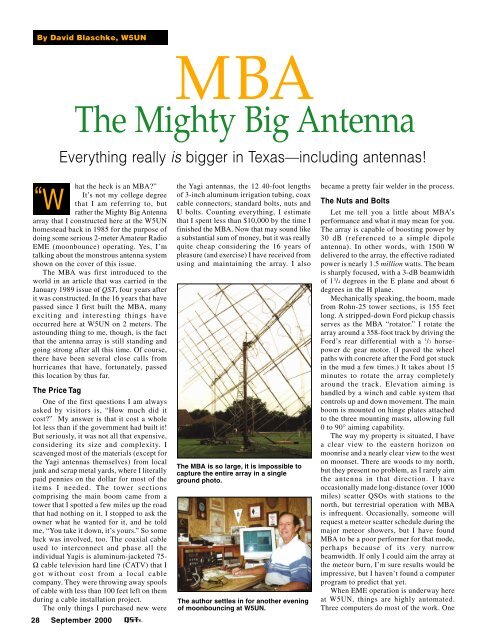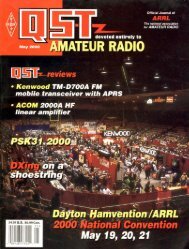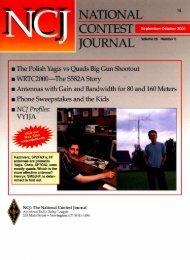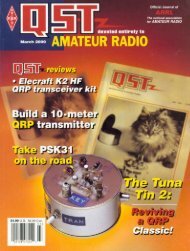By David Blaschke, W5UNMBAThe Mighty Big AntennaEverything really is bigger in Texas—including antennas!“What the heck is an MBA?”It’s not my college degreethat I am referring to, butrather the Mighty Big Antennaarray that I constructed here at the W5UNhomestead back in 1985 for the purpose ofdoing some serious 2-meter Amateur RadioEME (moonbounce) operating. Yes, I’mtalking about the monstrous antenna systemshown on the cover of this issue.The MBA was first introduced to theworld in an article that was carried in theJanuary 1989 issue of <strong>QST</strong>, four years afterit was constructed. In the 16 years that havepassed since I first built the MBA, manyexciting and interesting things haveoccurred here at W5UN on 2 meters. Theastounding thing to me, though, is the factthat the antenna array is still standing andgoing strong after all this time. Of course,there have been several close calls fromhurricanes that have, fortunately, passedthis location by thus far.The Price TagOne of the first questions I am alwaysasked by visitors is, “How much did itcost?” My answer is that it cost a wholelot less than if the government had built it!But seriously, it was not all that expensive,considering its size and complexity. Iscavenged most of the materials (except forthe Yagi antennas themselves) from localjunk and scrap metal yards, where I literallypaid pennies on the dollar for most of theitems I needed. The tower sectionscomprising the main boom came from atower that I spotted a few miles up the roadthat had nothing on it. I stopped to ask theowner what he wanted for it, and he toldme, “You take it down, it’s yours.” So someluck was involved, too. The coaxial cableused to interconnect and phase all theindividual Yagis is aluminum-jacketed 75-Ω cable television hard line (CATV) that Igot without cost from a local cablecompany. They were throwing away spoolsof cable with less than 100 feet left on themduring a cable installation project.The only things I purchased new were28 <strong>September</strong> <strong>2000</strong>the Yagi antennas, the 12 40-foot lengthsof 3-inch aluminum irrigation tubing, coaxcable connectors, standard bolts, nuts andU bolts. Counting everything, I estimatethat I spent less than $10,000 by the time Ifinished the MBA. Now that may sound likea substantial sum of money, but it was reallyquite cheap considering the 16 years ofpleasure (and exercise) I have received fromusing and maintaining the array. I alsoThe MBA is so large, it is impossible tocapture the entire array in a singleground photo.The author settles in for another eveningof moonbouncing at W5UN.became a pretty fair welder in the process.The Nuts and BoltsLet me tell you a little about MBA’sperformance and what it may mean for you.The array is capable of boosting power by30 dB (referenced to a simple dipoleantenna). In other words, with 1500 Wdelivered to the array, the effective radiatedpower is nearly 1.5 million watts. The beamis sharply focused, with a 3-dB beamwidthof 1 3 /4 degrees in the E plane and about 6degrees in the H plane.Mechanically speaking, the boom, madefrom Rohn-25 tower sections, is 155 feetlong. A stripped-down Ford pickup chassisserves as the MBA “rotator.” I rotate thearray around a 358-foot track by driving theFord’s rear differential with a 1 /3 horsepowerdc gear motor. (I paved the wheelpaths with concrete after the Ford got stuckin the mud a few times.) It takes about 15minutes to rotate the array completelyaround the track. Elevation aiming ishandled by a winch and cable system thatcontrols up and down movement. The mainboom is mounted on hinge plates attachedto the three mounting masts, allowing full0 to 90° aiming capability.The way my property is situated, I havea clear view to the eastern horizon onmoonrise and a nearly clear view to the weston moonset. There are woods to my north,but they present no problem, as I rarely aimthe antenna in that direction. I haveoccasionally made long-distance (over 1000miles) scatter QSOs with stations to thenorth, but terrestrial operation with MBAis infrequent. Occasionally, someone willrequest a meteor scatter schedule during themajor meteor showers, but I have foundMBA to be a poor performer for that mode,perhaps because of its very narrowbeamwidth. If only I could aim the array atthe meteor burn, I’m sure results would beimpressive, but I haven’t found a computerprogram to predict that yet.When EME operation is underway hereat W5UN, things are highly automated.Three computers do most of the work. One
The 1947 Ford pickup chassis and 1 /3 horsepower dc motor thatrotates the MBA.Here you can clearly see the concrete tracks as well as thecable tie-down that secures the MBA when it is not in use.computer handles antenna-aiming chores. Asecond computer monitor displays a 2-kHzwide “waterfall” spectrogram 1 of the audiobandpass that I happen to be tuned to. Thethird sends the CW, handles sequencetiming, and transmit/receive. It also handlesmy logging chores. All of this automationfrees me to concentrate on the importantthings, like digging call signs and reportsout of the noise. 2The PossibilitiesMany modestly equipped stations havebeen worked via EME since 1985; among thesmallest was ZD8MB, who was running lessthan 25 W to a single short Yagi antenna. Thishappened during an ARRL EME contest. Youdon’t normally expect a telephone call froma ham on Ascension Island requesting aschedule, but that is exactly how it happenedafter he heard me calling CQ.Another modestly equipped station thatI worked was CO2KK. Arnie called mefrom Havana, Cuba after our QSO andinvited me to be an interview guest onRadio Havana, where he hosts a radioprogram about Amateur Radio.Working stations running 50 to 100 Wto well-designed single Yagi antennas (thosewith boom length of three or more wavelengths)has become almost routine, butnever boring. I have heard my own echoesmore than once while transmitting with onewatt. Hearing and working modestlyequipped stations requires that conditionsbe at their very best, with the Moon nearperigee and minimal sky noise in theMoon’s direction.What all of this can mean for you is thatif you are operational on 2 meters, and yourstation is modestly equipped as describedabove, you have an excellent chance ofhearing W5UN’s echo as it reflects from theMoon’s surface. To hear me, you must aimyour antenna toward the Moon and tune tothe frequency where I normally operate ontwo meters. 3 If you can copy W5UN, then youcan also reasonably expect that W5UN willdetect your signal and hear you if you aredelivering 100 W or more to your antennaThe MBA elevation winch and azimuthposition transducer (under the ice creambucket).when you transmit. Of course, mostmoonbounce operating is done using CW.SSB is uncommon and FM is never usedbecause it is poorly suited for weak signalwork. If you cannot aim your antenna at theMoon when it is overhead, then you will haveto wait until the Moon is either rising orsetting. You will have about one hour’s worthof “Moon view” during each of these timeswithout elevating the angle of your antenna.EME transmitting and receiving timesare based on using one- or two-minutesequences. I normally transmit during theeven minutes, and listen during the oddminutes. Keep that in mind if you are goingto make an attempt to contact me. The CWspeed will be 20 WPM, which is the speedI find best for getting informationexchanged when making QSOs. 4You have an excellent chance to workthe MBA and many other moonbouncestations in October and November duringthe <strong>2000</strong> ARRL International EME Competition.You’ll find complete ruleselsewhere in this issue.MBA AccomplishmentsSome very interesting things haveoccurred here as a result of having the largeantenna array. In October 1990, I was ableto assist AMSAT personnel in rescuing theDOVE-OSCAR 17 satellite. Using theMBA, we were able to send a signal strongenough to unlock Dove’s 2-meter receiverfrom being swamped by the transmittersignal. AMSAT presented me with abeautiful plaque to commemorate theoccasion, which I still proudly display herein the shack.Then, of course, there was the accomplishmentof working enough differentcountries to win the first DXCC on2 meters, a feat thought impossible only afew years earlier. My wife and I personallyflew to ARRL Headquarters in January1991 to hand deliver the coveted QSLs.I said at the time, “After all the work ittook, I want to be on the plane carryingthese cards if it goes down.” The current2-meter DXCC country total at W5UNstands at 161.I cannot fully express how much enjoymentI have received, and how many friendsI have made in these sixteen years since theMBA was put into service. Perhaps you willbe one of the future contacts with W5UN.If so, you will be placed in good companyamong the more than 10,000 2-meter EMEQSOs, with nearly 2400 different stationsthat are already in the 2-meter log here.You can contact the author at 9102 Kings Dr,Manvel, TX 77578; w5un@wt.net.Notes1The spectrogram waterfall display is providedby AF9Y’s FFTDSP software. You can findout more about it on the Web at: http://www.webcom.com/af9y/radio10.htm.2 My software, Skymoon and Cwkey5, areshown on the W5UN Web site at: http://web.wt.net/~w5un.3W5UN can be found on 144.041 MHz whenon the air. A good time to listen is duringEME contests.4 Full operating procedures are explained indetail on W5UN’s Web site (see above).<strong>September</strong> <strong>2000</strong> 29
- Page 6 and 7: September 2000 Volume 84 Number 9C
- Page 11 and 12: THE AMERICAN RADIORELAY LEAGUE INCT
- Page 14: Get to Know Your Section ManagerThe
- Page 18: Cosponsors for S.2183Introduced by
- Page 22 and 23: Calling All Holiday Photos!Calling
- Page 26 and 27: CORRESPONDENCEYour opinions count!
- Page 32 and 33: By Bill Wageman, K5MATGrid Chasing:
- Page 34 and 35: By Dan Wissell, N1BYTThe OCR II Rec
- Page 36 and 37: 34 September 2000 Figure 1
- Page 38 and 39: its signal in a general-coverage re
- Page 40 and 41: By Dick Goodman, WA3USGThe Monster
- Page 42 and 43: Figure 4—Schematic diagram of the
- Page 44 and 45: elative power levels of the control
- Page 46 and 47: The elegant Butterfly with its ATVp
- Page 48 and 49: Ross Hull, 3JU, at his station inMe
- Page 50 and 51: By Jean Wolfgang, WB3IOSJamboree On
- Page 52 and 53: By Lew Malchick, N2RQSchool Club Ro
- Page 54 and 55: By Dave Patton, NT1NARRL Board Thin
- Page 56 and 57: Summary of Major Board ActionsMinut
- Page 58 and 59: Manager, delivered his report on th
- Page 60 and 61: ucts, and promote more efficient us
- Page 62 and 63: Figure 3—To change your display c
- Page 64 and 65: ity suffers. That is, it’s more d
- Page 66 and 67: in building a higher-performance re
- Page 68 and 69: SHORT TAKESEZNEC 3.0 for WindowsBy
- Page 70 and 71: HINTS & KINKSDOX CONTROL FOR A YAES
- Page 72 and 73: HAPPENINGSARRL Says Amateur Service
- Page 74 and 75: Seminole County to erect a 35-foot
- Page 76 and 77: Reviewed by Rich Arland, K7SZQST Co
- Page 78 and 79:
through an antenna tuner, and was r
- Page 80 and 81:
to use lighter plug equipped vehicl
- Page 82 and 83:
PUBLIC SERVICEThe Trials and Reward
- Page 84 and 85:
HOW’S DX?Tristan da Cunha and Gou
- Page 86 and 87:
THE WORLD ABOVE 50 MHZInto the 21st
- Page 88 and 89:
were more than half a dozen 2-meter
- Page 90 and 91:
health, safety and aesthetics conce
- Page 92 and 93:
AMATEUR SATELLITESA “Hot” After
- Page 94 and 95:
Christopher R.Gonyea, KB1AZKGoshen,
- Page 96 and 97:
QRP POWERVintage QRPFiring up an ol
- Page 98 and 99:
HAMFEST CALENDAR† ARRL HamfestAtt
- Page 100 and 101:
Mobile to the Max















